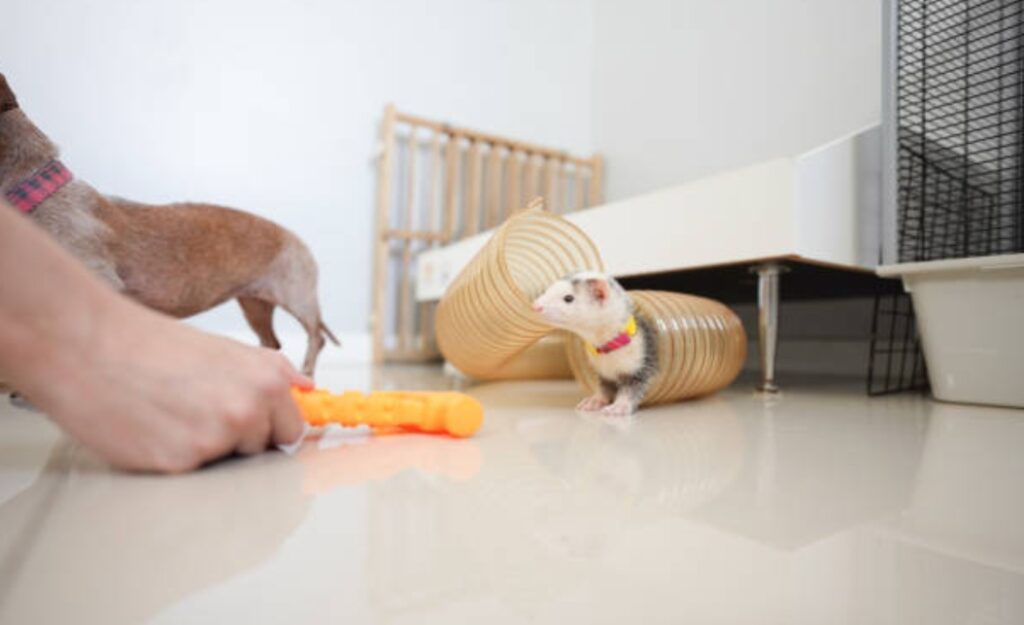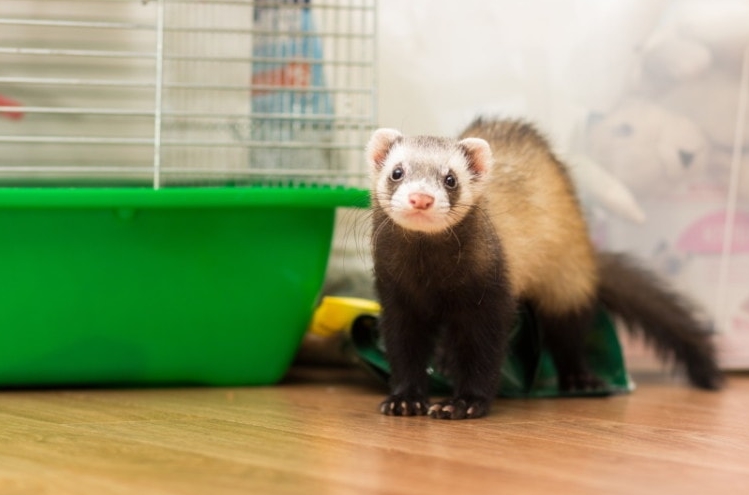Training your ferret is an essential part of being a responsible pet owner. Not only does it help you build a stronger bond with your furry friend, but it can also make your life easier by teaching your ferret to behave appropriately. keep reading to learn How to Train a Ferret and Ferrets Training Tips and Tricks.
To get started with ferret training, it’s important to establish trust with your pet and choose the right rewards for their efforts. You can then teach your ferret basic commands like coming when called and using a litter box. As your ferret becomes more advanced, you can also teach them fun tricks and obstacle courses. It’s important to stay patient and consistent with your training, avoiding punishment and rewarding progress instead. If you encounter any issues, like biting or stubbornness, there are ways to address them. With some time and effort, you can train your ferret to be a well-behaved and happy pet.
Introduction of Ferret Training
Training your ferret is a crucial aspect of being a responsible pet owner. Proper training enables your ferret to behave appropriately in various situations. By teaching your ferret basic commands and tricks, you can make life easier for both you and your furry friend. In this blog post, we’ll discuss effective ferret training tips and tricks that will help you train your pet in a way that’s fun, easy, and rewarding.
Why training your ferret is important

Ferret training is vital for a few reasons. Firstly, it helps to establish a strong bond between you and your pet, which is essential for their mental and emotional well-being. Secondly, training your ferret can help them to behave appropriately in various situations, such as using a litter box or coming when called. This makes life easier for both you and your pet. Finally, training your ferret can be a fun and rewarding experience for both you and your pet.
What to expect from ferret training
When you start training your ferret, it’s essential to be patient and consistent. Ferrets are intelligent animals, but they can be stubborn at times, so it’s important to remain calm and positive throughout the process. You can expect to see progress over time, but it’s important not to rush your pet. Some ferrets may take longer to learn than others, and that’s perfectly normal. With the right approach and plenty of patience, you can train your ferret to be a well-behaved and happy pet.
Getting Started with Ferret Training
Before you start training your ferret, it’s important to establish trust with your pet. Establishing trust with your ferret can be done by spending time with them and offering them treats. You can sit near their cage or playpen and talk to them in a soothing voice. Offer them treats like small pieces of cooked chicken or turkey, and let them approach you on their own terms. Avoid forcing your ferret to interact with you, as this can cause them to become scared or aggressive. Over time, your ferret will learn to trust you and will become more willing to interact with you and learn from you during training sessions.
Setting up a training area

When it comes to training your ferret, having a designated training area can be helpful. This area should be a quiet space with minimal distractions, like a spare room or a corner of your living room. Make sure the area is safe and free from hazards like electrical cords or sharp objects. You can also use a playpen to keep your ferret contained and focused during training sessions.
Choosing the right rewards for your ferret
Ferrets are motivated by positive reinforcement, so it’s important to choose the right rewards for your pet. Treats like small pieces of cooked chicken or turkey are great options, but you can also use toys or playtime as rewards. It’s important to choose rewards that your ferret enjoys and that are safe for them to consume. Avoid using treats that are high in sugar or fat, as these can be harmful to your ferret’s health. By offering the right rewards, you can encourage your ferret to learn and perform commands.
Basic Training Commands for Ferrets
Teaching your ferret basic commands is an essential part of ferret training. Here are a few basic commands you can teach your pet:
Teaching your ferret to come when called
Start by calling your ferret’s name and rewarding them with a treat when they come to you. Repeat this process regularly and gradually increase the distance between you and your pet. You can also use a clicker to train your ferret to come when called. When your ferret comes to you, click the clicker and reward them with a treat.
Training your ferret to use a litter box

Why Do Ferrets Stink: Effective Odor-Free Management for Ferrets
Ferrets can be trained to use a litter box just like cats. Start by placing the litter box in a designated area and show your ferret where it is. When your ferret uses the litter box, reward them with a treat. If your ferret has an accident outside of the litter box, clean it up and place the waste in the litter box to help your ferret understand where it should be going.
Teaching your ferret to walk on a leash
Walking your ferret on a leash can be a fun way to bond with your pet and give them exercise. Start by introducing your ferret to the harness and leash and rewarding them with treats for allowing you to put it on. Let your ferret get used to the harness and leash by allowing them to wear it indoors for short periods of time. Once your ferret is comfortable, take them outside on a leash and reward them with treats for walking with you. Be patient and don’t force your ferret to do anything they’re not comfortable with.
Advanced Ferret Training Techniques
Once your ferret has mastered the basic commands, you can move on to more advanced training techniques. Here are a few ideas:
Training your ferret to do tricks

Ferrets are intelligent and can learn a variety of tricks, like rolling over or standing up on their hind legs. Start by using a clicker to mark the behavior you want your ferret to perform, and then reward them with a treat. Repeat the process regularly and gradually increase the difficulty of the trick.
Training your ferret to do tricks can be a fun and rewarding way to bond with your pet. With patience and persistence, ferrets can learn a variety of tricks, like standing up on their hind legs or even playing dead. Using positive reinforcement techniques like clicker training and rewarding your ferret with treats can help make the training process more enjoyable for both you and your pet.
Teaching your ferret to navigate obstacle courses
Setting up an obstacle course for your ferret can be a fun and challenging way to train them. Start by introducing your ferret to each obstacle and rewarding them with a treat for completing it. Once your ferret is comfortable with each obstacle, put them all together and reward your ferret for completing the course.
Obstacle courses can be a great way to challenge your ferret’s agility and intelligence. With proper training, ferrets can learn to navigate through tunnels, jump over obstacles, and even climb ramps. Gradually increasing the difficulty of the course and rewarding your ferret with treats can help keep them motivated and engaged throughout the training process.
Training your ferret to respond to hand signals
Using hand signals can be a helpful way to communicate with your ferret during training sessions. Start by associating a hand signal with a command, like holding your hand up for “stop” or pointing for “go.” Use the hand signal consistently and reward your ferret when they respond correctly. Over time, your ferret will learn to associate the hand signal with the corresponding command.
Tips for Successful Ferret Training
Training your ferret can be a fun and rewarding experience, but it requires patience and consistency. Here are some tips to help ensure successful training:
Staying patient and consistent with your training
Ferrets can take time to learn new commands and tricks, so it’s important to stay patient and consistent with your training. Avoid getting frustrated or giving up if your ferret doesn’t respond right away. Instead, keep practicing and rewarding your ferret for the progress made.
Avoiding punishment and negative reinforcement
Punishing your ferret or using negative reinforcement techniques like yelling or hitting can be harmful to your ferret’s mental and physical health. Instead, focus on positive reinforcement techniques like clicker training and rewarding good behavior with treats and praise.
Recognizing and rewarding your ferret’s progress

What Do Ferrets Eat: Ferret’s Healthy Diet
It’s important to recognize and reward your ferret’s progress during training. Whether it’s taking a few steps on a leash or using the litter box for the first time, rewarding your ferret for their achievements can help keep them motivated and engaged in the training process.
Recognizing and rewarding your ferret’s progress is an essential part of successful training. Whether it’s learning a new trick or simply following a command correctly, acknowledging your ferret’s achievements can help keep them motivated and excited to continue training. Using positive reinforcement techniques like treats, toys, and praise can help reinforce good behavior and make training a fun and enjoyable experience for both you and your ferret.
Troubleshooting Common Ferret Training Issues
Ferret training can sometimes come with its own set of challenges. Here are some tips for troubleshooting common ferret training issues:
Dealing with biting and aggression
Ferrets may bite or show aggression during training, especially if they feel scared or threatened. It’s important to never hit or yell at your ferret in response to biting or aggression, as this can worsen the behavior. Instead, try redirecting their attention to a toy or treat, and slowly reintroduce the training session once they have calmed down.
Overcoming fear and shyness

Some ferrets may be naturally timid or afraid of new things, making training more difficult. Patience and positive reinforcement are key in helping your ferret overcome their fear and shyness. Start with small and simple training exercises, and gradually increase the difficulty as your ferret becomes more comfortable.
Addressing stubbornness and lack of motivation
Ferrets can be stubborn at times, and may not always feel motivated to participate in training. If your ferret seems uninterested or uncooperative, take a break and try again later. It’s also important to ensure that you are using positive reinforcement techniques and rewards that your ferret finds appealing. If the issue persists, consult with a veterinarian or animal behaviorist for additional guidance. Ferret – Wikipedia
Common Questions and Answers for Ferret Training
- How to potty train a ferret?
- Consistent use of a litter box, placing the ferret in the litter box after eating or playing, and rewarding successful use of the litter box can help potty train a ferret.
- How to litter train a ferret?
- Offering multiple litter boxes in different locations, using a high-backed litter box, and using a litter that the ferret prefers can help litter train a ferret.
- How to train a ferret to use a litter box?
- By consistently placing the ferret in the litter box after meals or playtime and rewarding successful use of the litter box, you can train your ferret to use a litter box.
- How to train your ferret?
- Training your ferret requires patience, consistency, and positive reinforcement. Start with basic commands like “come” and “stay” and gradually progress to more advanced tricks.
- How do you potty train a ferret?
- Potty training a ferret involves consistently placing the ferret in the litter box after meals or playtime, using positive reinforcement to reward successful use of the litter box, and cleaning up accidents quickly to prevent repeat incidents.
- How to train a ferret to hunt rabbits?
- It is not recommended to train ferrets to hunt rabbits as it can be dangerous for both the ferret and the rabbit.
- How to get your ferret to stop biting?
- Redirecting the ferret’s attention with a toy or a treat, saying “no” firmly and consistently, and avoiding rough play can help get your ferret to stop biting.
- How to get ferrets to stop pooping everywhere?
- Consistent use of a litter box, rewarding successful use of the litter box, and cleaning up accidents quickly can help get your ferret to stop pooping everywhere.
- How to train your ferret to use the litter box?
- Consistently placing the ferret in the litter box after meals or playtime, offering multiple litter boxes in different locations, and using a litter that the ferret prefers can help train your ferret to use the litter box.
- How do ferrets use the bathroom?
- Ferrets use a litter box to go to the bathroom, similar to cats.
- How do you train a ferret?
- Training a ferret requires patience, consistency, and positive reinforcement. Start with basic commands like “come” and “stay” and gradually progress to more advanced tricks.
- How to stop ferrets from pooping everywhere?
- Consistent use of a litter box, rewarding successful use of the litter box, and cleaning up accidents quickly can help stop ferrets from pooping everywhere.
- How do you litter train a ferret?
- Offering multiple litter boxes in different locations, using a high-backed litter box, and using a litter that the ferret prefers can help litter train a ferret.
- How to potty train your ferret?
- Consistently placing the ferret in the litter box after meals or playtime, using positive reinforcement to reward successful use of the litter box, and cleaning up accidents quickly can help potty train your ferret.
- How to bite train a ferret?
- It is not recommended to “bite train” a ferret, as biting is a natural behavior for ferrets. Instead, redirect their attention with a toy or treat and avoid rough play.
- How to train a ferret to come?
- Using a treat or toy as a reward and saying the command “come” consistently while the ferret is walking towards you can help train a ferret to come.
- How to get ferrets to poop in a litter box?
- Consistently placing the ferret in the litter box after meals or playtime, using positive reinforcement to reward successful use of the litter box, and cleaning up accidents quickly can help
Conclusion of How to Train a Ferret

In conclusion, training your ferret can be a fun and rewarding experience for both you and your pet. Remember to start with the basics, such as establishing trust and setting up a training area, before moving on to more advanced techniques.
Key takeaways from this guide include staying patient and consistent with your training, avoiding punishment and negative reinforcement, and recognizing and rewarding your ferret’s progress.
As you continue to train your ferret, don’t be discouraged by setbacks or challenges. Troubleshoot common training issues, such as biting and stubbornness, and seek help if needed.
Overall, training your ferret can help strengthen the bond between you and your pet, while also promoting good behavior and obedience. With dedication and perseverance, you can successfully train your ferret and enjoy a happy and fulfilling relationship with your furry friend
Learn How to Take Care of a Ferret: 7 Essential Tips for Beginners
We would love to hear from you! If you have any questions, tips, or personal experiences to share about training your ferret, please leave a comment below. Your input can help others who are embarking on the same journey with their furry friends. Let’s build a community of ferret lovers and share our knowledge!
